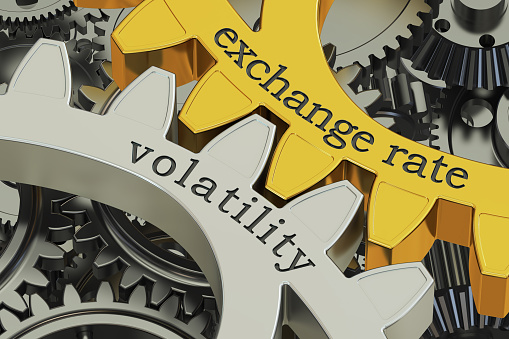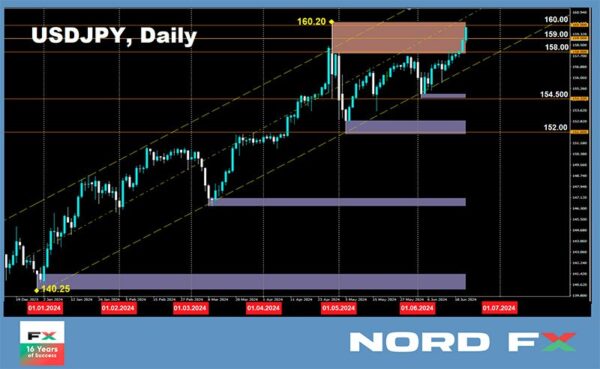News
Forex and Cryptocurrency Forecast – Action Forex

EUR/USD: Eurozone – Rising Inflation, Falling Economy
As revised Eurostat data published on Monday, June 17, showed, inflation (CPI) in the 20 Eurozone countries accelerated to 2.6% (y/y) in May, compared to 2.4% in April when it was at its lowest since November 2023. The consumer price index in the services sector increased annually from 3.7% to 4.1%. Core inflation, excluding the cost of food and energy (CPI Core), accelerated to 2.9% in May, compared to 2.7% in April – the lowest since February 2022.
Such growth in consumer prices gave euro bulls a faint hope that the European Central Bank (ECB) would slow down the rate cut. Against this backdrop, EUR/USD went up, reaching a local high of 1.0760. However, the business activity statistics (PMI) in the Eurozone, released on June 21, showed that to support the economy, the rate needs to be reduced further, not frozen at the current level of 4.25%.
In Germany, the locomotive of the European economy, the PMI index in the manufacturing sector was 43.4 points in June, worsening compared to the May figure of 45.4 and significantly below the forecast of 46.4. The PMI index in the services sector fell from 54.2 to 53.5, failing to meet market expectations of 54.4. The preliminary Composite PMI index for Germany also declined in June to 50.6 points, against the forecast of 52.7 and 52.4 in May. It is worth noting that all three indicators were the weakest in the last two months.
Eurozone statistics, in general, were not very encouraging. According to preliminary data, the PMI index in the manufacturing sector fell from 47.3 in May to 45.6 in June, missing the forecast of 47.9. The PMI index in the services sector decreased from 53.2 to 52.6 (forecast 53.5). The Composite PMI fell from 52.2 to 50.8 (forecast 52.5) and nearly reached the critical mark of 50.0 points, separating progress from regression.
After these data were released, market participants awaited similar statistics from the USA, which were to be published at the end of the workweek. The Composite PMI showed that business activity in the US private sector, unlike the Eurozone, continues to grow confidently. According to preliminary estimates, this indicator increased from 54.5 in May to 54.6 in June. The PMI in the manufacturing sector grew from 51.3 to 51.7 over the same period, while the services sector business activity index increased from 54.8 to 55.1. All these indicators exceeded analysts’ expectations (51.0 and 53.4, respectively).
In addition to PMI data, the Fed’s monetary policy report at the end of Friday also drew significant interest. Following its publication, EUR/USD ended the week at 1.0691. Regarding the analysts’ forecast for the near term, as of the evening of June 21, it remained unchanged from seven days ago. Thus, 60% of experts voted for the pair’s decline, 20% for its growth, and another 20% remained neutral. In technical analysis, 100% of trend indicators and oscillators on D1 sided with the dollar and turned red, although a quarter of the latter are in the oversold zone. The nearest support for the pair is in the 1.0665-1.0670 zone, followed by 1.0600-1.0615, 1.0565, 1.0495-1.0515, 1.0450, and 1.0370. Resistance zones are located at 1.0760, then at 1.0810, 1.0890-1.0915, 1.0945, 1.0980-1.1010, 1.1050, and 1.1100-1.1140.
Next week, there is plenty of interesting and important information expected from the USA. On Tuesday, June 25, the US Consumer Confidence Index will be published. On Wednesday, June 26, we will learn the results of the US bank stress test. On Thursday, June 27, data on the US GDP for Q1 2024 and the number of initial jobless claims in the country will be released. Finally, at the end of the workweek, on Friday, June 28, data on the US consumer market, including such an important inflation indicator as the Core Personal Consumption Expenditure Index, will be published.
GBP/USD: How the Interest Rate Will Fall
On Wednesday, June 19, a day before the Bank of England (BoE) meeting, consumer inflation (CPI) data was published in the UK. Overall, the picture was quite good. The consumer price index remained at the previous level of 0.3% month-on-month, lower than the projected 0.4%. Year-on-year, the CPI fell from 2.3% to 2.0%, reaching the central bank’s target for the first time since October 2021. The core index (Core CPI), excluding volatile components such as food and energy prices, also showed a noticeable decrease from 3.9% to 3.5% (y/y).
The still high level of inflation in the services sector was disappointing. This indicator was higher than forecasted in the central bank’s May report and amounted to 5.7% (y/y) against the expected 5.3%. “Indicators such as rent growth remain quite high. […] These data confirm that the Bank of England will not lower rates at tomorrow’s meeting,” commented ING Bank strategists on the published statistics on June 19, and they were right.
At its meeting on Thursday, June 20, the Bank of England left the key interest rate unchanged for the seventh consecutive time, at 5.25%. Seven members of the Monetary Policy Committee voted for such a decision, two votes were cast for lowering the rate, and zero votes for increasing it. According to several policymakers, such a decision by the regulator was “finely balanced.”
The latest data on inflation in the services sector is unlikely to prevent the BoE from starting a cycle of easing its monetary policy (QE) in the second half of the year. Especially since, according to the Committee members, the higher-than-expected CPI was due to one-off wage payment factors.
If the parliamentary elections in the UK on July 4 and the inflation report on July 17 do not present significant surprises, the Bank of England is expected to begin lowering rates as early as August. As ING Bank strategists write, “markets are pricing in a 43% probability of the first rate cut in August and expect easing by 46 basis points (bps) by the end of the year.” TDS analysts, in turn, give the following forecast: “We expect a 15 bps rate cut by the August meeting and around 50 bps in total for 2024.” Several other market participants’ forecasts also suggest a reduction of about 30 bps by November.
On the day after the BoE meeting, Friday, June 21, the Office for National Statistics (ONS) published fresh data on retail sales in the UK, which were significantly higher than forecasted. In May, they increased by 2.9% (m/m) after falling by -1.8% in April, with markets expecting a growth of 1.5%. The core retail sales index, excluding automotive fuel, also grew by 2.9% (m/m) against a previous decline of -1.4% and a market forecast of 1.3%. Year-on-year, retail sales increased by 1.3% compared to April’s decrease of -2.3%, while core retail sales rose by 1.2% (y/y) against -2.5% a month earlier.
Preliminary business activity (PMI) data were mixed. However, overall, they showed that the UK’s economy is on the rise. PMI in the manufacturing sector increased from 51.2 to 51.4 points (forecast 51.3). Business activity in the services sector amounted to 51.2, below the previous value of 52.9 and the forecast of 53.0. The Composite PMI showed a slight decline to 51.7 against the forecast of 53.1 and 53.0 a month earlier. Despite the last two indicators being below previous values, they still remain above the 50.0 horizon separating economic growth from decline.
Against this backdrop, the pound attempted to recoup some losses but failed, and GBP/USD ended the week at 1.2643, turning strong support in the 1.2675 zone into resistance.
The analysts’ forecast for the near term looks neutral: 50% of experts voted for the dollar to strengthen, while the same number (50%) preferred the British currency.
As for technical analysis on D1, the advantage is on the dollar’s side. Among trend indicators, the ratio of forces between red and green is 75% to 25% in favour of the former. Among oscillators, 85% point south (a quarter signals the pair is oversold) and only 15% look north. If the pair continues to fall, it will encounter support levels and zones at 1.2575-1.2610, 1.2540, 1.2445-1.2465, 1.2405, and 1.2300-1.2330. In the event of the pair’s growth, it will face resistance at levels 1.2675, 1.2740-1.2760, 1.2800-1.2820, 1.2850-1.2860, 1.2895-1.2900, 1.2965-1.2995, 1.3040, and 1.3130-1.3140.
As for the events of the coming week, not many are expected. Among the most important is the publication of the UK’s GDP data on Friday, June 28.
USD/JPY: BoJ Rate Hike Chances Close to Zero
At its meeting on June 13-14, the Bank of Japan (BoJ) kept the interest rate unchanged at 0.1%. Recall that in March this year, the central bank made a “bold” move by raising the rate for the first time since 2007 (it had been at a negative level of -0.1% since 2016). However, after this single rate hike in 17 years, the BoJ is unlikely to continue raising it in the foreseeable future, no matter how much some analysts and investors might want it.
Such desires and forecasts are popular due to the very low level of the Japanese currency. In early 2011, USD/JPY traded around 76.00, and since then, the yen has weakened more than twofold – on April 29, 2024, the pair reached a level of 160.22, the highest since 1986. This negatively affects national businesses. The benefits of a weak yen for exports do not cover the negatives for imports, as the trade balance is negative; the country imports more than it exports. Expensive imports, primarily raw materials and energy, reduce production profitability. GDP growth rates are falling – in Q1 2024, this indicator showed an economic contraction to -1.8% (y/y) compared to +0.4% in the previous quarter. Additionally, the national debt relative to GDP is approaching 265%.
In such a situation, the economy needs support, not restraint by raising the key interest rate. Moreover, compared to other G10 countries, inflation in Japan is low and has been steadily declining in recent months. According to fresh data, the national CPI index, excluding food and energy prices, fell from 2.4% to 2.1%. Moreover, in June, it could fall below the BoJ’s target level of 2.0%. Thus, combating inflation by raising rates is unnecessary and even harmful. But how can the yen’s position be strengthened then?
Another method besides tightening monetary policy (QT) is currency interventions. Japan’s top currency diplomat Masato Kanda stated on June 20 that the government “will respond carefully to excessive currency movements” and that he “has never felt limited in the potential for currency interventions” and that the interventions conducted in May “were quite effective in combating excessive currency movements caused by speculators.”
The words are beautiful. However, looking at the chart, one would argue with the official about the effectiveness of the interventions. Of course, USD/JPY retreated from the 160.00 mark for a while. But this period was quite short, and now it is again approaching this height. One can also recall similar actions in previous years, which only temporarily restrained the national currency’s weakening.
This time, it seems officials have come up with another way to increase the effectiveness of monetary policy without changing rates. According to Reuters, the Ministry of Finance’s commission is likely to urge the government to issue shorter-maturity debt obligations to reduce the risk of interest rate changes. (For reference, the yield on 10-year Japanese government bonds currently exceeds 0.9%, nine times the central bank’s rate).
The last chord of the past week for USD/JPY was set at 159.79. The continuation of the Fed’s tight policy, confirmed at the June meeting, and the BoJ’s ongoing soft policy still play in favour of the dollar. (Although, of course, new currency interventions are not excluded). Economists from Singapore’s United Overseas Bank (UOB) believe that only a breakthrough of support at 156.50-156.80 will indicate that the pair’s current upward momentum has faded.
The median forecast of experts for the near term is as follows: 75% of them voted for the pair’s move south and the yen’s strengthening (apparently expecting new interventions), while the remaining 25% pointed north. Indicators show the opposite picture; they have not even heard about interventions. Therefore, all 100% of trend indicators and oscillators on D1 are green, although 20% of the latter are in the overbought zone. The nearest support level is around 158.65, followed by 157.60-158.20, 156.80-157.05, 156.00-156.10, 155.45-155.80, 154.50-154.70, 153.60, 152.85, 151.85, 150.80-151.00, 149.70-150.00, 148.40, 147.60, and 146.50-147.10. The nearest resistance is in the 160.00-160.20 zone, followed by 162.50.
The upcoming week looks busy on Friday, June 28. On this day, data on consumer inflation (CPI) in the Tokyo region will be published, as well as data on industrial production volumes and the labour market situation in Japan. No other important economic statistics are planned for the coming days.
CRYPTOCURRENCIES: Patience, Patience, and More Patience
In the last review, we published a forecast by MN Capital founder Michael van de Poppe, who expected BTC/USD to fall to the $60,000-65,000 range. The analyst was essentially correct – the week’s low was recorded on Friday, June 21, when the price dropped to around $63,365.
This time, we want to draw attention to the forecast of another influencer, the president of Euro Pacific Capital and a fierce opponent of cryptocurrencies, Peter Schiff. We have quoted his apocalyptic predictions multiple times. This time, the financier outlined a possible hedge fund strategy that would lead to bitcoin’s collapse. According to him, investors in exchange-traded BTC spot ETFs treat digital gold as a speculative asset. Schiff noted that bitcoin has been in a “sideways” trend for the third month, trading below the March high. With such dynamics, investors might lose patience and decide to close positions at some point, causing BTC quotes to collapse amid a lack of liquidity.
It must be said that Schiff’s negative forecast has some basis – in recent days, American spot Bitcoin ETFs have indeed shown an outflow of funds. Since June 7, their cumulative balance has decreased by $879 million to $15 billion. Over the past two weeks, long-term whale holders have sold digital gold worth $1.2 billion, with more than $370 million attributed to GBTC. Thus, whales and ETFs have collectively created downward pressure worth $1.7 billion during this time.
Of course, a cryptocurrency market crash is unlikely, no matter how much Peter Schiff might want it. However, the current situation raises concerns among many specialists. Usually, bullish cryptocurrency markets are fueled by general enthusiasm around the digital coin. However, analysts at IntoTheBlock observe that despite a surge in activity among major holders (whales) earlier this year, there is no influx of new participants in the market. In fact, the number of primary BTC users has sharply dropped to multi-year lows, falling to levels seen during the bear market of 2018. This lack of growth creates a critical misunderstanding of why investors are not buying bitcoins. “Retail investors remain on the sidelines,” IntoTheBlock notes.
Perhaps it is all due to the relaxed summer mood, general macroeconomic gloom, lack of sources of fresh money inflow, and other drivers. But everything can change, of course. Speaking at the BTC Prague 2024 conference, MicroStrategy CEO Michael Saylor reiterated that bitcoin should be considered one of the safest assets today. When asked by journalists whether it is time to sell BTC, the entrepreneur replied that the asset currently lacks fundamental growth catalysts, but a price rise should be expected soon. According to Michael Saylor, those who show patience will later receive enormous profits from owning digital gold. (For reference: MicroStrategy is the largest holder of bitcoins among public companies, with 205,000 BTC on its balance sheet, worth over $13 billion).
Analysts at the financial company Bernstein have raised the target price of the first cryptocurrency to $200,000 by the end of 2025. The forecast is driven by expectations of “unprecedented demand from spot bitcoin ETFs managed by BlackRock, Fidelity, Franklin Templeton, and others.” “We believe that ETFs have become a turning point for cryptocurrencies, causing structural demand from traditional pools of capital. In total, ETFs have attracted around $15 billion in new net funds,” Bernstein’s explanatory note reads.
According to the company’s experts, bitcoin is in a new bullish cycle. They called the halving a unique situation where natural selling pressure from miners is halved or more, and new demand catalysts for cryptocurrency appear, leading to exponential price movements. Analysts pointed to previous cycles: in 2017, digital gold rose to a high roughly five times the marginal production cost and then fell to a low of 0.8 of this figure in 2018. “During the 2024-2027 cycle, we expect bitcoin to rise to 1.5 times this metric, implying a cycle high of $200,000 by mid-2025,” Bernstein believes.
For now, at the time of writing, on the evening of Friday, June 21, the BTC/USD pair is far from $200,000 and trades at $64,150. The total cryptocurrency market capitalization stands at $2.34 trillion ($2.38 trillion a week ago). The Bitcoin Fear & Greed Index dropped from 70 to 63 points over 7 days but remains in the Greed zone.
To conclude the review, here’s news from the world of Artificial Intelligence. For many years, there have been ongoing debates about the imperfections of the first cryptocurrency’s concept. Some accuse the coin’s creator, Satoshi Nakamoto, of shortsightedness, while others criticize the project’s technical execution. To find out what’s wrong with bitcoin, the editorial team at BeInCrypto asked the latest version of ChatGPT to analyze the cryptocurrency’s whitepaper published by Nakamoto in October 2008. As a result, Artificial Intelligence found several shortcomings and errors in the main document of the crypto industry, some of which seem quite serious:
1. The 51% rule. The whitepaper claims that the network is secure if more than 50% of the power is controlled by honest participants. However, practice has shown that under certain conditions, attacks are possible with fewer resources.
2. Anonymity. The document mentions user anonymity, but bitcoin provides only pseudonymity. Transactions can be traced back to specific users.
3. Scalability. The document did not foresee scalability issues that became apparent with the network’s popularity growth. High transaction volumes lead to delays and increased fees.
4. Software updates. The document does not address the need for regular software updates to maintain network security and implement new features.
5. Fork resistance. The document does not consider risks associated with network hard forks. Forks like Bitcoin Cash polarize the community, potentially reducing the network’s value.
6. Regulation and legal issues. The document does not mention potential legal and regulatory obstacles for bitcoin. Since its publication, many countries have introduced or are considering regulatory measures.
7. Mining difficulty. The document’s author did not foresee the significant increase in mining difficulty and the energy consumption changes. Modern mining requires enormous computing power and electricity. According to Greenpeace, in 2023, global bitcoin mining consumed approximately 121 TWh of electricity, comparable to the energy consumption of a country like Poland. This has led to significant CO2 emissions and serious atmospheric pollution, as stated in Greenpeace’s report.
News
US Cryptocurrency Rules Delayed by ‘Never-Ending’ Lawsuits

Ripple CEO says cryptocurrency industry still seeking regulatory clarity from US
Speaking to Bloomberg News on Wednesday (July 17), Author: Brad Garlinghouse he said America is behind behind other countries which have already adopted cryptocurrency regulations.
“What we’re seeing, where it’s the UK, Japan, Singapore… even the European Union, more than two dozen countries have come together to provide a framework for cryptocurrency regulation,” Garlinghouse said.
“It’s frustrating that we as a country can’t get that regulatory framework in place. And instead, we have this never-ending lawsuit coming from the SEC that doesn’t really address the problem.”
Ripple has been the target of some of these legal disputes. Securities and Exchange Commission (SEC) sued the company in 2020, accusing it of conducting a $1.3 billion operation offering of unregistered securities tied to its XRP token.
However, last year a judge ruled that only Ripple’s institutional sales of XRP, not retail sales, violated the law, a decision widely seen as a victory for the cryptocurrency industry.
As PYMNTS noted at the time, that ruling has “far-reaching repercussions impact across the digital asset ecosystem, which has long maintained that its tokens do not represent securities contracts.”
However, Garlinghouse told Bloomberg on Wednesday that the company cannot wage multimillion-dollar legal battles over each token.
He spoke to the news agency from the Republican National Convention in Milwaukee, where the party is backing the candidacies of former President Donald Trump and Ohio Sen. J.D. Vance, both of whom are considered pro-cryptocurrency.
But Garlinghouse argued that cryptocurrencies “should not be a partisan issue,” and noted that he had recently attended a conference in Washington that included Democrats, including White House officials.
“I think they were there, listening to the industry… it was refreshing to start having that conversation,” she said.
President Joe Biden earlier this year he vetoed a measure which would have ended the SEC’s special rules for crypto-asset custodians. This legislation was supported by both the digital asset industry and the banking industry.
Ripple early this year donated $25 million to the cryptocurrency industry’s super PAC Fair Smoothiewith Garlinghouse stating at the time that such donations would continue every year, as long as the industry had its detractors.
Second Open SecretsWhich monitor spending For campaigns, the PAC has spent $13.4 million this year, much of it to help defeat Rep. Katie Porter’s (D-Calif.) U.S. Senate campaign.
News
The Future of Cybersecurity in the Cryptocurrency Industry

The cryptocurrency space has had a tumultuous journey, with its fair share of ups and downs. As we look to the future, one area that remains a constant focus is cybersecurity. The digital nature of cryptocurrencies makes them inherently vulnerable to cyber threats, and as the industry evolves, so does the landscape of potential risks.
In 2022, the cryptocurrency market faced significant challenges, with over $2 trillion in market value lost. This event served as a wake-up call for the industry, highlighting the need for robust cybersecurity measures. The future of cryptocurrency security is expected to see a shift towards more regulated and established institutions taking the reins of crypto technology and blockchain infrastructure.
The decentralized nature of cryptocurrencies offers numerous benefits, such as transparency and financial inclusion. However, it also introduces unique security challenges. The risk landscape is filled with threats such as hacking, phishing, ransomware attacks, malware, and social engineering. These threats not only lead to financial losses, but also damage the reputation and trust within the cryptocurrency ecosystem.
Mini-MBA Tekedia edition 15 ((September 9 – December 7, 2024) started recordings; Register today for discounts reserved for early bird customers.
Tekedia AI in Business Masterclass Opens registrations Here.
Join the Tekedia Capital Syndicate and IInvest in Africa’s best startups Here.
The decentralized nature of cryptocurrencies offers many benefits, but it also presents unique security challenges. Cyber risks such as hacking, phishing, and ransomware pose threats to the integrity of digital assets. The infrastructure that supports cryptocurrencies is not immune to vulnerabilities, including smart contract flaws and exchange hacks.
To address these vulnerabilities, the infrastructure that supports cryptocurrencies must be strengthened. Smart contract vulnerabilities, exchange hacks, wallet breaches, and flaws in the underlying blockchain technology are significant concerns that must be addressed to ensure the security and integrity of digital assets.
As cybercriminal tactics and techniques become more sophisticated, the cryptocurrency industry must stay ahead of the curve. The future will likely see more targeted attacks, exploiting weaknesses in infrastructure, networks, and human factors. This requires a proactive and multifaceted approach to cybersecurity.
To mitigate these risks, several measures must be adopted:
Strengthening security measures: Developers, exchanges, and wallet providers must improve security protocols, use strong encryption, implement multi-factor authentication, and conduct regular security audits.
Education and awareness: Users should be educated on best practices for protecting their digital assets, including using strong passwords, recognizing phishing attempts, and using hardware wallets for secure storage.
Looking ahead, the cryptocurrency industry is expected to see an increased focus on robust security measures. Blockchain projects and exchanges are likely to invest in advanced encryption techniques and decentralized storage solutions to protect user assets. The future impact of cyber risk on cryptocurrencies will depend on the collective efforts of stakeholders to address vulnerabilities and strengthen security measures.
Collective efforts by stakeholders in the cryptocurrency space are crucial to address vulnerabilities and strengthen security measures. While challenges persist, advances in cybersecurity technologies and practices offer hope for a more secure and resilient cryptocurrency ecosystem.
The future of cybersecurity in the cryptocurrency industry depends on finding a balance between innovation and regulation. It requires a collaborative effort from all parties involved, from developers to end users, to create a secure environment that fosters trust and growth in the industry. As we move forward, it is critical that lessons learned from past events guide the development of stronger security measures, ensuring the longevity and stability of cryptocurrencies as a vital part of the modern economic toolkit.
Like this:
Like Loading…
News
Bullish XRP and RLBK price predictions rise, outpacing the broader cryptocurrency market, prompting Shiba Inu holders to switch!

Bitcoin’s one-week surge from $60,000 has pushed other cryptocurrencies into an uptrend. However, for many altcoins, this trend has been temporary. Altcoins such as XRP and Shiba Inu (SHIB) have experienced price drops. However, Rollblock, a new altcoin on the Ethereum blockchain, has thrived during this period, attracting thousands of investors looking for long-term growth.
XRP’s Nearly 30% Growth Over Last Week Drops as Selling Pressure Increases
XRP is seeing further price decline as Ripple investors withdraw their profits from the token. The surge in XRP’s price to $0.64 in the past week has provided investors with a perfect opportunity to increase their returns in the short term. With the ongoing sell-off in XRP, XRP has jumped over 8% in the past day and is now trading at $0.59. However, analysts tracking XRP indicators predict that XRP could still extend its gains by over 30% in the coming weeks.
Shiba Inu (SHIB) marks its third consecutive day of losses
Shiba Inu (SHIB) is in a period of adjustment after a week of strong gains. In the last 24 hours, SHIB has seen a jump of over 7%, reflecting a natural market fluctuation. Analysts are observing a death cross on the Shiba Inu chart, which historically signals the potential for future opportunities as the market stabilizes. As investors explore new possibilities, some are diversifying into promising altcoins like Rollblock (RBLK) to strategically rebalance their portfolios and capitalize on the emerging trend.
Rollblock (RBLK) Up Another 7% as New Investors Join Pre-Sale
Rollblock (RBLK) has taken the cryptocurrency market by storm, having attracted investors from more popular altcoins like Shiba Inu (SHIB) and XRP. Rollblock’s growth is attributed to its utility in the $450 billion global gaming industry.
Rollblock aims to use blockchain technology to bridge the gap between centralized and decentralized gambling. With blockchain technology, Rollblock secures every transaction in its online casino, providing transparency and convenience to millions of players who are uncomfortable placing bets on other iGaming platforms.
This innovative use of blockchain technology in the industry has grown Rollblock to over 4,000 new users in less than two months. With plans to add sports betting, this number is expected to grow exponentially in Q3.
Rollblock uses a revenue sharing model that splits up to 30% of its casino’s weekly profits with token holders. This happens after Rollblock buys back $RBLK from the open market and uses half of it for rewards. The other half is burned to increase the price of $RBLK.
Rollblock price has seen four increases in the past month with $RBLK tokens now selling for $0.017. Analysts predict that at the current growth rate, Rollblock could increase by over 800% before the presale ends. For investors looking for a long-term token with growth potential, phase four is the best time to buy Rollblock before its price skyrockets!
Discover the exciting Rollblock (RBLK) pre-sale opportunities now!
Website:https://Rollblockpresale.io/
Social: https://linktr.ee/Rollblockcasino
No spam, no lies, just insights. You can unsubscribe at any time.
News
Texas Crypto Miners Turn to AI as Crypto Declines

As cryptocurrency mining becomes less profitable, Texas cryptocurrency mining companies are switching to supporting artificial intelligence companies.
Bitcoin miners, with their sprawling data centers and access to significant energy resources, are ideally suited for computationally intensive AI operations, and as cryptocurrency mining becomes less profitable, companies see this shift as a logical answer to their problems.
On Thursday, Houston-based Lancium and Denver-based Crusoe Energy Systems announced a multibillion-dollar deal to build a 200-megawatt data center near the West Texas city of Abilene to support advanced artificial intelligence applications such as medical research and aircraft design, CNBC reported. The plant represents the first phase of a larger 1.2 gigawatt project.
Lancium and Crusoe’s move into AI mirrors a broader trend among bitcoin miners. The combined market capitalization of the top U.S.-listed bitcoin miners hit a record $22.8 billion in June. Companies like Bit Digital and Hut 8 are diversifying into AI, with Bit Digital securing a $92 million annual revenue deal to supply Nvidia GPUs and Hut 8 raising $150 million to expand its AI data center.
But the growing popularity of these operations also presents challenges, particularly for the Texas power grid. Last month, the Electric Reliability Council of Texas announced that the state is expected to nearly double its energy production by 2030 to meet the high energy demands of data centers and cryptocurrency operations.
Lieutenant Governor Dan Patrick expressed concern about the projections.
“Cryptocurrency miners and data centers will account for more than 50% of the additional growth. We need to take a close look at these two sectors,” He wrote on Twitter/X. “They produce very few jobs compared to the incredible demands they place on our network. Cryptocurrency miners could actually make more money selling electricity to the network than they do from their cryptocurrency mining operations.”
Analysts predict significant growth in data center power capacity, which is expected to account for up to 9% of U.S. electricity consumption by 2030.
The operations also pose challenges for nearby cities. Earlier this month, TIME reported that a crypto-mining facility was seriously compromising the health of residents in the city of Granbury. TIME reported more than 40 people with serious health problems, including cardiovascular disease, high blood pressure and hearing loss. At least 10 of the residents needed to go to the emergency room or an urgent care facility.
The disturbances were caused by the extreme noise generated by the crypto-mining facility’s fans, which are used to keep the machines cool. While the proposed data center in Abilene would use liquid cooling systems, it’s still unclear whether the facility’s operations would pose a health risk to local residents.
-

 Nfts1 year ago
Nfts1 year agoShardLab Launches ZK-Based Tool for Digital Identity and NFT Vouchers
-

 News1 year ago
News1 year agoWallet recovery firms are abuzz as stranded cryptocurrency investors panic in the bitcoin boom
-

 Bitcoin1 year ago
Bitcoin1 year agoBitcoin, Ethereum, Solana and Cryptocurrency Markets Look Ready to ‘Send’ as Stars Align, According to Investor Chris Burniske
-

 Altcoins1 year ago
Altcoins1 year agoThree Altcoins Poised for Significant Growth in 2024: ETFS, OP, BLAST
-

 Altcoins1 year ago
Altcoins1 year agoAccumulate these altcoins now for maximum gains
-

 Nfts1 year ago
Nfts1 year agoOG Crypto Artist Trevor Jones Unveils Groundbreaking Collection of Ordinals | NFT CULTURE | NFT News | Web3 Culture
-

 Bitcoin1 year ago
Bitcoin1 year agoBillionaires are selling Nvidia stock and buying an index fund that could rise as much as 5,655%, according to some Wall Street analysts
-

 Videos9 months ago
Videos9 months agoKamala just won the boner! [Bad For Crypto]
-

 Videos1 year ago
Videos1 year agoLIVE FOMC 🚨 Could be CATASTROPHIC for Altcoins!
-

 News1 year ago
News1 year agoA Guide for Newcomers & Beginners – Forbes Advisor
-

 Videos1 year ago
Videos1 year agoAttention: a historically significant BITCOIN signal has just appeared!
-

 Videos1 year ago
Videos1 year agoSTOCK MARKET FUD! ⚠️ [Why This Is GREAT For Bitcoin Traders!]















